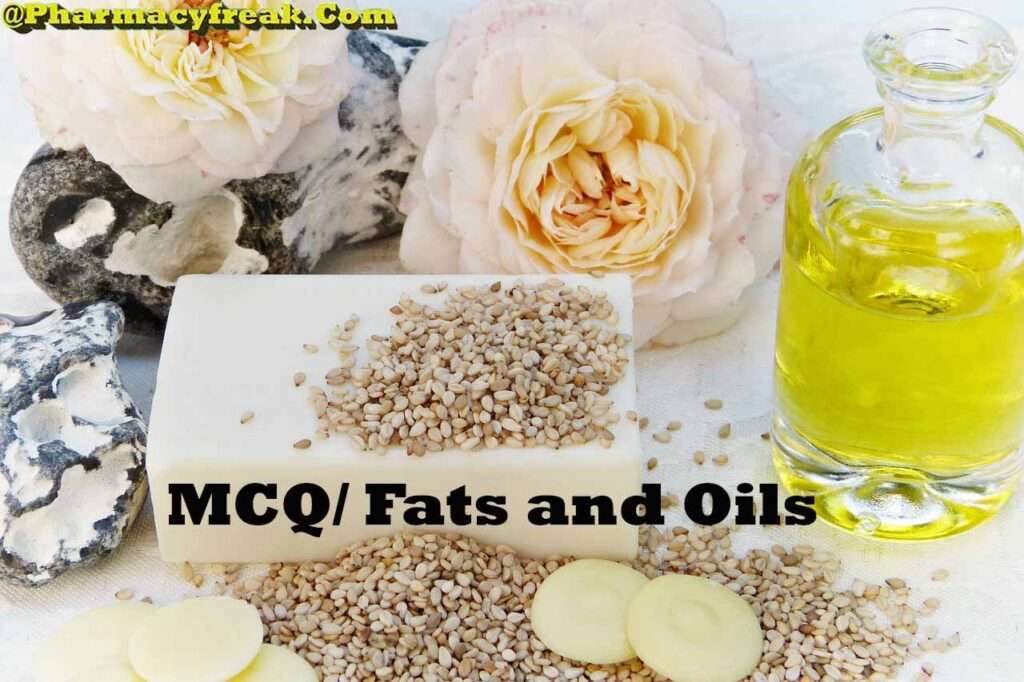MULTIPLE CHOICE QUESTIONS of Fats and Oils of Pharmaceutical organic Chemistry B.Pharmacy 3rd semester.

1. Fats and oils are ester of
- a) Acetic acid and alcohols
- b) Fatty acid and alcohols
- c) Carboxylic acid and alcohols
- d) None of above
Answer- b) Fatty acid and alcohols
2. Melting point of fat is…………..and melting point of oil is…………..
- a) Higher, higher
- b) Lower, lower
- c) Higher, lower
- d) Lower, higher
Answer- c) Higher, lower
3. Which of the following is an example of fats?
- a) Vegetable ghee
- b) Ground nut oil
- c) Coconut oil
- d) Glyceryl trioleate
Answer- a) Vegetable ghee
4. Pick out the correct statement
- a) Oils are saturated triglycerides
- b) Oils are liquids at room temperature
- c) Oils have lower melting points
- d) None of above
Answer- a) Oils are saturated triglycerides
5. Enzyme responsible for hydrolysis of fat is?
- a) Reductase
- b) Aconitase
- c) Lipase
- d) Kinase
Answer- c) Lipase
6. Which of the following is suitable solvents/s for oils and fats?
- a) Benzene
- b) CCI4
- c) CHCL3
- d) All of above
Answer- d) All of above
7. Saponification is done
- a) By alkali hydrolysis
- b) By acids
- c) By salts
- d) All of above
Answer- a) By alkali hydrolysis
8. Fats do not have……….. bonds and oils have……… bonds
- a) Triple, double
- b) Double, double
- c) Double, triple
- d) Triple, triple
Answer- b) Double, double
9. Vegetable ghee is manufactured by
- a) Saponification
- b) Hydrogenation
- c) Oxidative polymerisation
- d) Reduction polymerization
Answer- b) Hydrogenation
10. Hydrogenolysis is a reaction which leads to the reduction products of
- a) Aldefyde
- b) Ketone
- c) Alcohol
- d) Ester
Answer- c) Alcohol
11. Rancidity of lipids containing food is due to
- a) Hydrogenation of unsaturated fatty acids
- b) Reduction of fatty acids
- c) Oxidation of fatty acids
- d) Dehydrogenation of saturated fatty acids
Answer- c) Oxidation of fatty acids
12. Dietary fats are transported as-
- a) Chyclomicrons
- b) Liposomes
- c) Lipid globules
- d) Oil droplets
Answer- a) Chyclomicrons
13. The specific gravity of lipid is
- a) 0.2
- b) 0.8
- c) 1.0
- d) 1.5
Answer- b) 0.8
14. Fats with unsaturated fatty acids are……. at room temperature
- a) Solid
- b) Liquid
- c) Liquid in presence of oxygen
- d) Liquid in absence of oxygen
Answer- b) Liquid
15. The number of OH group in fats can be expressed as
- a) Polenske number
- b) RM value
- c) Acetyl value
- d) Iodine value
Answer- c) Acetyl value
16. The degree of unsaturation of lipid can be measured as
- a) Saponification value
- b) Iodine value
- c) RM value
- d) Polenske value
Answer- b) Iodine value
17. The number of mg of KOH require to neutralize fatty acid present in 1gm of fat is called
- a) Iodine value
- b) Saponification value
- c) Acid value
- d) RM value
Answer- b) Saponification value
18. Hydrogenolysis of fats and oil is done in the presence of which catalyst
- a) Copper-chromium
- b) Nickel
- c) H₂ gas
- d) Dil. H2SO4
Answer- a) Copper-chromium
19. The catalyst used in addition of iodine is
- a) Ni/pt
- b) Lewis acid
- c) CH3MgCl
- d) HgCl₂
Answer- d) HgCl₂
20. Which of the following is responsible for rancidity?
- a) Alkali
- b) Ketones
- c) Aldehydes
- d) Alcohols
Answer- c) Aldehydes
21. Iodine number is defined as the number of grams of iodine required for the iodination of gm of fats or oils
- a) 1
- b) 5
- c) 100
- d) 1000
Answer- c) 100
22. Which of the following helps in classification of oils into drying, semi drying and non drying oils?
- a) Acid value
- b) Iodine value
- c) Saponification value
- d) RH value
Answer- b) Iodine value
23. Which of the following is important in testing the purity of butter and ghee?
- a) RM value
- b) Acid value
- c) Iodine value
- d) Saponification value
Answer- d) Saponification value
- Pharmacognosy and phytochemistry mcq with answer
- Pharmacognosy MCQ with Answers
- Preservation of pharmaceutical products
- MCQ Solubility of Drugs, States of Matter Physical Pharmaceutics, B.Pharm 3rd semester
- MCQ cycloalkanes 3rd Semester B.pharmacy
- MCQ Polynuclear Hydrocarbons Pharmaceutical Organic Chemistry 3rd semester B.Pharmacy
- MCQ/ Fats and Oils Pharmaceutical Organic Chemistry 3rd semester B.Pharmacy
- MCQ Phenol pharmaceutical organic chemistry 3rd semester B.Pharmacy
- MCQ Benzene Pharmaceutical Organic Chemistry 3rd semester B.Pharmacy